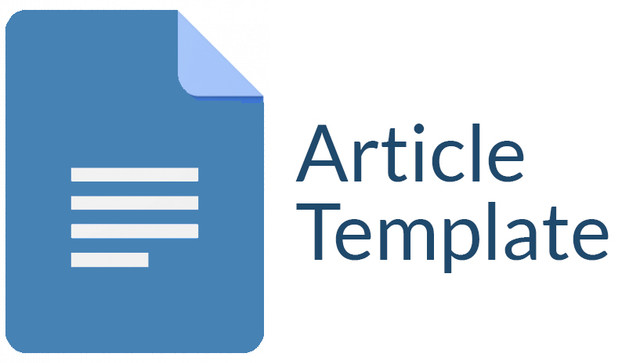The Implementation Of Advance Organizer Teaching Model To Improve The Junior High School Student’s Vocabulary
Keywords:
Advance Organizer Models, Learning Outcomes, VocabularyAbstract
This study aims to determine whether the advance organizer teaching model can improve the junior high school student’s vocabulary. Samples of this research is class VIII SMPN 2 Karangrejo Magetan , which consists of 32 students.This research is a classroom action research. The study is divided into three phases: pre-cycle, cycle I and cycle II. Data collection using a test instrument to determine learning outcomes of students in each cycle. Indicators of success in carrying out the study of which is the average grade of at least reach 75 with a minimum of 85% classical completeness.Once implemented through action learning model Advance Organizer in improving students' vocabulary, in cycle I percentage classical completeness 72% with an average of 74. While in cycle II percentage classical completeness 87% with an average grade of 80.
Downloads
References
Abdulloh, A., & Usman, R. (2021). The Effectiveness of Advance Organizer Learning Approach in Teaching Reading Narrative Text for First Year High School Students.
Avison, D. E., Lau, F., Myers, M. D., & Nielsen, P. A. (1999). Action research. Communications of the ACM, 42(1), 94–97. https://doi.org/10.1145/291469.291479
Çeliköz, N., Erişen, Y., & Şahin, M. (2016). Learning and Teaching : Theories , Approaches and Models Chapter 3 : Cognitive Learning Theories Learning and Teaching : Theories , Approaches and Models. Ankara, Turkey: Cozum Egitim Yayincilik, June, 31–45. https://www.researchgate.net/publication/304119354
Damairi, D., & Suyadi, S. (2022). The Use of Direct Method in Teaching Speaking to Grade Eight MTs Negeri 2 Kota Jambi in the Academic Year 2019/2020. Jurnal Ilmiah Universitas Batanghari Jambi, 22(3). https://doi.org/10.33087/jiubj.v22i3.2957
Feng, R., Alsager, H. N., Azizi, Z., & Sarabani, L. (2023). Impact of mind-mapping technique on EFL learners’ vocabulary recall and retention, learning motivation, and willingness to communicate. Heliyon, 9(6). https://doi.org/10.1016/j.heliyon.2023.e16560
Fitria, atul, Harjono, A., Ayub, S., & Kunci, K. (2021). Pengembangan Perangkat dengan Model Pembelajaran Advance Organizer untuk Meningkatkan Penguasaan Konsep dan Retensi Fisika Peserta Didik. 6(1). http://jurnalkonstan.ac.id/index.php/jurnalHalaman|11
Gunawan, G., Harjono, A., Nisyah, M., Kusdiastuti, M., & Herayanti, L. (2020). Improving students’ problem-solving skills using inquiry learning model combined with advance organizer. International Journal of Instruction, 13(4), 427–442. https://doi.org/10.29333/iji.2020.13427a
Khoerunnisa, P., Syifa, &, & Aqwal, M. (2020). ANALISIS MODEL-MODEL PEMBELAJARAN. In Jurnal Pendidikan Dasar (Vol. 4, Issue 1). https://ejournal.stitpn.ac.id/index.php/fondatia
Krepel, A., de Bree, E. H., Mulder, E., van de Ven, M., Segers, E., Verhoeven, L., & de Jong, P. F. (2021). Predicting EFL vocabulary, reading, and spelling in English as a foreign language using paired-associate learning. Learning and Individual Differences, 89. https://doi.org/10.1016/j.lindif.2021.102021
L MPhil Student, S. S. (2020). Advance Organizer Model. International Journal of Creative Research Thoughts, 8, 2320–2882. www.ijcrt.org
Lu, J., & Murao, R. (2023). The effect of working memory and English proficiency on Chinese EFL learners’ vocabulary learning with background music. Ampersand, 10. https://doi.org/10.1016/j.amper.2023.100126
Mccarten, J. (2007). Teaching Vocabulary Lessons from the Corpus, Lessons for the Classroom. www.cambridge.org
M.Hum, Dr. E. (2020). IMPROVING STUDENTS ABILITY ON ENGLISH FOR SPECIFIC PURPOSE (ESP) COURSE THROUGH STAR 7 JUMPS MODEL AT COACH STUDY PROGRAM FKIP- UNRI. JURNAL PAJAR (Pendidikan Dan Pengajaran), 4(1). https://doi.org/10.33578/pjr.v4i1.7920
Ren, B., Liu, M., Ding, R., & Liu, H. (2024). A Survey on 3D Skeleton-Based Action Recognition Using Learning Method. In Cyborg and Bionic Systems (Vol. 5). https://doi.org/10.34133/cbsystems.0100
Stringer, E. T., & Aragón, A. O. (2020). Action research. Sage publications.
Sunasuan, P., & Songserm, U. (2021). Using Advance Organizer Model to Influence the Meaningful Learning of New Concepts for ESL Learners in a Collaborative Classroom. Arab World English Journal, 12(3), 129–143. https://doi.org/10.24093/awej/vol12no3.9
Tete, S. (2020). EFFECTS OF ADVANCE ORGANIZERS TEACHING STRATEGY ON HEARING IMPAIRED STUDENTS’ ACHIEVEMENT AND RETENTION IN SOCIAL STUDIES IN RIVERS STATE. European Journal of Research and Reflection in Educational Sciences, 8(4). www.idpublications.org
Wahyudin, A. Y., Pustika, R., & Simamora, M. W. (2021). VOCABULARY LEARNING STRATEGIES OF EFL STUDENTS AT TERTIARY LEVEL. The Journal of English Literacy Education: The Teaching and Learning of English as a Foreign Language, 8(2), 101–112. https://doi.org/10.36706/jele.v8i2.15647
Warnby, M. (2023). Academic vocabulary knowledge among adolescents in university preparatory programmes. Journal of English for Academic Purposes, 61. https://doi.org/10.1016/j.jeap.2022.101203
Downloads
Published
Issue
Section
License

This work is licensed under a Creative Commons Attribution-ShareAlike 4.0 International License.
Authors who publish with this journal agree to the following terms:
1. Copyright on any article is retained by the author(s).
2. The author grants the journal, right of first publication with the work simultaneously licensed under a Creative Commons Attribution License that allows others to share the work with an acknowledgment of the work’s authorship and initial publication in this journal.
3. Authors are able to enter into separate, additional contractual arrangements for the non-exclusive distribution of the journal’s published version of the work (e.g., post it to an institutional repository or publish it in a book), with an acknowledgment of its initial publication in this journal.
4. Authors are permitted and encouraged to post their work online (e.g., in institutional repositories or on their website) prior to and during the submission process, as it can lead to productive exchanges, as well as earlier and greater citation of published work.
5. The article and any associated published material is distributed under the Creative Commons Attribution-ShareAlike 4.0 International License









